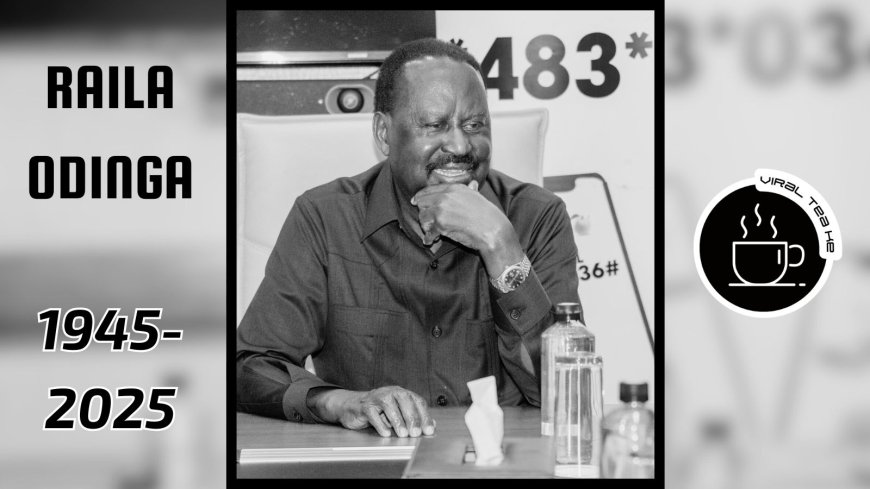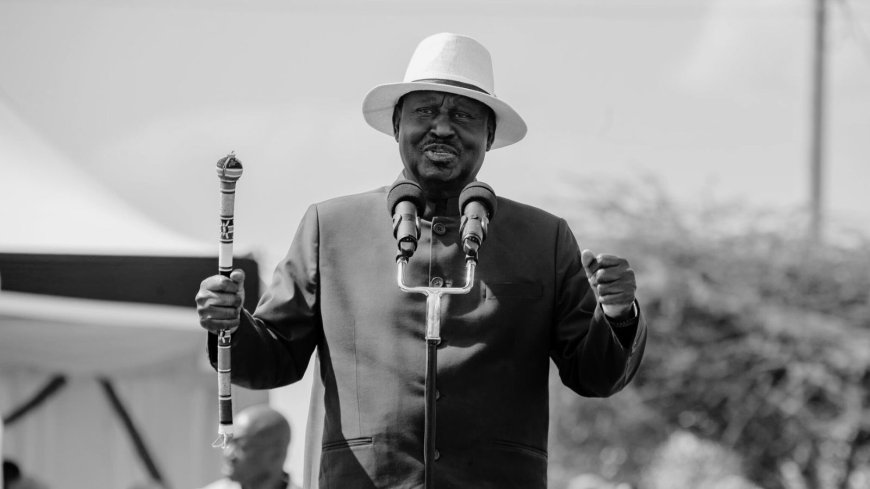Raila Amolo Odinga: The Enduring Legacy of Kenya’s 'Baba'
For over 40 years, Raila Odinga’s unwavering resolve has left a profound mark on Kenya’s political landscape.

80-year-old Raila Amollo Odinga will arguably go down in history as the 'father' of Kenyan politics. If the kids of today haven't told you his real story yet, we will.
Early Life, Education and Rise to Activism
Raila Amolo Odinga, born on January 7, 1945, in Maseno, Kisumu County, was one of Kenya’s most influential and polarising political figures.
The son of Jaramogi Oginga Odinga, Kenya’s first vice president, and Mary Juma Odinga, Raila was destined for public life. His father’s deep involvement in politics during Kenya’s independence era profoundly shaped his worldview, embedding in him a conviction that democracy and justice were worth fighting for—no matter the cost.
Raila attended Maranda High School, one of the top-performing institutions in the Nyanza region, before leaving for East Germany in the 1960s under a scholarship programme.

President William Ruto and the late Raila Odinga at State House. /PCS
He then studied at the Herder Institute in Leipzig, Germany for a year to learn German, then proceeded to the Technical University of Magdeburg, where he graduated in 1970 with a Master’s degree in Mechanical Engineering. While abroad, he was exposed to global revolutionary ideas and social justice movements that would later influence his brand of politics back home.
On returning to Kenya, Raila took up a teaching position at the University of Nairobi’s Department of Engineering and later joined the Kenya Bureau of Standards (KEBS), where he rose to become Deputy Director.
In the private sector, he also co-founded an engineering company, East African Spectre Ltd, which remains a family business today. But Raila’s ambitions went far beyond engineering—his heart was firmly set on political reform. His entry into politics, however, would come at a steep personal price.
Political Struggles, Detentions, and the Fight for Multiparty Democracy
Raila Odinga’s political journey was forged in the crucible of resistance. The 1980s were a turbulent decade in Kenya, defined by Daniel arap Moi’s one-party rule, intolerance of dissent, and widespread human rights violations.
Raila became one of the few bold voices demanding constitutional freedoms and political pluralism. In 1982, following an attempted coup by a section of the Kenya Air Force, Raila was accused of involvement in the plot. Although he denied any role, he was detained without trial for six years, marking the beginning of a long cycle of imprisonment, torture, and exile.
He was released in 1988 but rearrested in 1989 and again in 1990 for his continued pro-democracy activism. After intense domestic and international pressure, Raila was released for good in 1991 and fled to Norway to escape possible re-arrest.
That same year, Kenya repealed Section 2A of the Constitution, officially restoring multiparty democracy—a victory that Raila and other activists like Kenneth Matiba and Charles Rubia had fought tirelessly to achieve.
When he returned to Kenya later that year, Raila helped form the Forum for the Restoration of Democracy (FORD), a coalition that quickly gained momentum as the main opposition to Moi’s regime. However, internal divisions split the party into factions, and in the 1992 elections—Kenya’s first multiparty poll—Raila was elected Member of Parliament for Lang’ata Constituency under the FORD-Kenya banner, led by his father. Following Jaramogi’s death in 1994, Raila took over the party leadership but later defected to the National Development Party (NDP) in 1997 after internal wrangles.
The 1997 general election marked Raila’s first presidential bid, where he finished third but gained nationwide visibility, even though this would mark the beginning of five consecutive presidential bids that failed.
His growing influence led him to a controversial alliance with Moi’s ruling KANU party in 2001, earning him an appointment as Minister for Energy. He used the position to initiate reforms in Kenya’s power sector, but his partnership with Moi soon soured.
When Moi endorsed Uhuru Kenyatta as his successor, Raila led a massive KANU split and joined the Rainbow Alliance, which later formed the National Rainbow Coalition (NARC)—the team that swept Mwai Kibaki into power in the historic 2002 election.
Power, Contention and the Road to Prime Minister
When Kibaki took office in 2003, Raila was appointed Minister for Roads, Public Works, and Housing, and his supporters expected him to be named Prime Minister as part of a pre-election Memorandum of Understanding. That promise never materialised, triggering one of the most dramatic political fallouts in Kenya’s history.
Raila led a faction known as the Liberal Democratic Party (LDP), which opposed Kibaki’s government in the 2005 constitutional referendum. His side won, dealing a major political blow to Kibaki and cementing Raila’s reputation as a master tactician and defender of constitutional reform.
In the 2007 presidential election, Raila ran under the Orange Democratic Movement (ODM) against incumbent Kibaki. The results were fiercely contested, with widespread allegations of vote rigging. The disputed outcome triggered post-election violence that left over 1,000 people dead and displaced hundreds of thousands.
International mediation, led by former UN Secretary-General Kofi Annan, produced a power-sharing agreement, creating the position of Prime Minister, which Raila occupied from 2008 to 2013 in Kenya’s first grand coalition government.
Also Read: 5 Times Raila Has Struck Handshake Deals With Kenya's Presidents
As Prime Minister, Raila oversaw key reforms, including the passage of the 2010 Constitution, which introduced devolution, reduced presidential powers, and expanded civil liberties. This remains one of his most enduring legacies.

Uhuru Kenyatta and Raila Odinga during the 'handshake' in 2018. /CAPITAL GROUP
He also championed infrastructure expansion and anti-corruption initiatives, though critics accused his administration of failing to curb graft and inefficiency. Nonetheless, he emerged from his tenure as one of Africa’s most respected reformist politicians.
Raila would make three more unsuccessful presidential bids—in 2013, 2017, and 2022. In 2017, he rejected the results after the Supreme Court nullified the election, accusing the Independent Electoral and Boundaries Commission (IEBC) of manipulation.
Also Read: How Raila's Fifth Election Loss Was Boosted By Opinion Polls
His symbolic “swearing-in” as the “People’s President” in January 2018 further deepened political tensions. Yet, in a surprising twist two months later, he reconciled with President Uhuru Kenyatta through the now-famous “Handshake”—a truce that reshaped Kenya’s political dynamics and birthed the Building Bridges Initiative (BBI).
While the BBI’s constitutional proposals were ultimately struck down by the courts, it underscored Raila’s long-standing desire for national unity and institutional reform.
Death, Legacy and the End of an Era
Raila Odinga’s final years were marked by his continued push for political inclusivity and electoral justice. Despite losing the 2022 election to William Ruto, he remained a dominant voice in national discourse, leading mass protests in 2023 over the cost of living and alleged corruption within government. His commitment to holding power accountable never waned, even as age and health challenges began to slow him down.
On October 15, 2025, while on a private visit to Kochi, India, Odinga collapsed and was pronounced dead shortly after arrival at a local hospital. Reports indicated that the 80-year-old veteran politician suffered a cardiac arrest.
News of his death sent shockwaves across Kenya and the continent, with leaders from Africa and beyond paying tribute to his lifelong service to democracy and social justice. President Ruto described him as “a patriot who gave everything for Kenya,” while international outlets like Reuters, AP, and The Guardian hailed him as one of Africa’s most consequential opposition figures.
Raila’s political journey was defined by resilience, sacrifice, and an almost prophetic persistence. He endured imprisonment, torture, exile, betrayal, and five unsuccessful presidential campaigns—but never abandoned his quest for a more equitable Kenya.
To his supporters, he was “Baba”, the father of Kenya’s democratic transition. To critics, he was a polarising figure whose confrontational politics sometimes deepened divisions. Yet, even his fiercest opponents acknowledged his unmatched influence in shaping Kenya’s modern political identity.
His contribution to Kenya’s multiparty democracy, the 2010 Constitution, and the fight for electoral justice will remain central to the country’s political history. Few leaders in Africa have managed to maintain relevance across five decades of political transformation as Raila did—from the Moi dictatorship to the digital age.
His death marks the end of an era—the departure of a revolutionary who refused to conform, who challenged systems of oppression, and who, despite never occupying the State House, arguably left a larger imprint than many presidents.
As Kenya mourns him, Raila Odinga’s story serves as a reminder that leadership isn’t always measured by the offices one holds but by the impact one leaves behind. His was a life of defiance, endurance, and unwavering hope in Kenya’s potential.
Even in death, Raila’s legacy endures—in the constitution he helped birth, the freedoms he fought for, and the millions he inspired to believe that change, however delayed, is always worth fighting for.
Editor's note: May Raila Odinga rest in peace. Viral Tea sends our condolences to the family and friends of Raila Odinga, as well as comfort during this difficult time.







